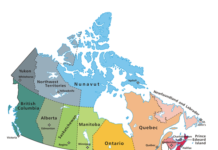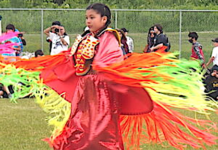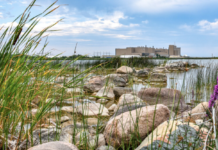Wreaths today are seen as a decoration for a front door or in a window or above a fireplace. At one time however, wreaths were much more.
In ancient times, they were used as a head dress to depict social status. The shape and material used in a wreath contained symbolic meanings and, during the Victorian age, they gained popularity as creative works by ladies who used a wide variety of mediums including wool, cotton, feathers and even hair.
Wreaths were usually created in two shapes – circles and horseshoes. The circle represents something never-ending and horseshoes were seen as lucky – open end up means gathering luck inside and open end down means luck will pour out under those who walk underneath.
At Bruce County Museum and Cultural Centre (BCM&CC), ‘Victorian Hang Ups: Symbolism & Sentiment’ explores the history of wreaths, their rise in popularity during the Victorian Age, the symbolic meanings found within them and the different materials used to create them.

In early modern England, a wreath custom existed for the funerals of “young maidens”. A young woman of the same age as the one being mourned would lead the funeral procession, carrying a wreath of white flowers to represent the purity of the deceased, and “that eternal crown of glory reserved for her in heaven”.[30]
By the Victorian era, the symbolism of flowers had grown to become an elaborate language, and the symbolism of funeral wreaths was no exception. Flowers represented life and resurrection. Specific flowers were used in funeral wreaths to represent particular sentiments. Cypress and willow were used for crafting wreath frames, and were associated with mourning by the Victorians.

In early modern England, a wreath custom existed for the funerals of “young maidens”. A young woman of the same age as the one being mourned would lead the funeral procession, carrying a wreath of white flowers to represent the purity of the deceased, and “that eternal crown of glory reserved for her in
heaven”.

A wreath that uses several shades of blonde and brunette hair with beading. The shadow box frame is stamped and tooled leather leaves and flowers – a must see
In the 1800s, giving a lock of one’s hair to another was a sign of intimacy and the Victorian age was all about sentimentality and hair was chosen as a reminder of loved one, living or dead. Contributors to a hair wreath were usually family members or good friends.
By the Victorian era, the symbolism of flowers had grown to become an elaborate language, and the symbolism of funeral wreaths was no exception. Flowers represented life and resurrection. Specific flowers were used in funeral wreaths to represent particular sentiments. Cypress and willow were used for crafting wreath frames, and were associated with mourning by the Victorians.












